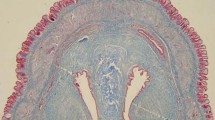Abstract
Ischemic priapism is a distressing condition that frequently results in severe organic erectile dysfunction in young men. Various models for studying this disorder have enabled several advances in the understanding of priapism over the past few years. Researchers are slowly discovering the contributions of metabolic and cellular components of ischemia to cavernosal smooth muscle failure. In addition, the etiology of recurrent priapism in men susceptible to the disease is becoming clear.
Similar content being viewed by others
References and Recommended Reading
Kulmala RV, Lehtonen TA, Tammela TL: Priapism, its incidence and seasonal distribution in Finland. Scand J Urol Nephrol 1995, 29:93–96.
Eland IA, van der Lei J, Stricker BH, Sturkenboom MJ: Incidence of priapism in the general population. Urology 2001, 57:970–972.
Kulmala RV, Lehtonen TA, Tammela TL: Preservation of potency after treatment for priapism. Scand J Urol Nephrol 1996, 30:313–316.
Montague DK, Jarow J, Broderick GA, et al.: American Urological Association guideline on the management of priapism. J Urol 2003, 170(Suppl 4 Pt 1):1318–1324. This systematic review of the literature includes recommendations for the stepwise management of priapism.
Pryor J, Akkus E, Alter G, et al.: Priapism. J Sex Med 2004, 1:116–120. This paper is another systematic review with recommendations for the management of priapism.
Ciampalini S, Savoca G, Buttazzi L, et al.: High-flow priapism: treatment and long-term follow-up. Urology 2002, 59(1):110–113.
Juenemann KP, Lue TF, Abozeid M, et al.: Blood gas analysis in drug-induced penile erection. Urol Int 1986, 41:207–211.
Broderick GA, Harkaway R: Pharmacologic erection: timedependent changes in the corporal environment. Int J Impot Res 1994, 6:9–16.
Broderick GA, Gordon D, Hypolite J, Levin RM: Anoxia and corporal smooth muscle dysfunction: a model for ischemic priapism. J Urol 1994, 151:259–262.
Kim NN, Kim JJ, Hypolite J, et al.: Altered contractility of rabbit penile corpus cavernosum smooth muscle by hypoxia. J Urol 1996, 155:772–778.
Saenz de Tjada I, Kim NN, Daley JT, et al.: Acidosis impairs rabbit trabecular smooth muscle contractility. J Urol 1997, 157:722–726.
Moon DG, Lee DS, Kim JJ: Altered contractile response of penis under hypoxia with metabolic acidosis. Int J Impot Res 1999, 11:265–271.
Muneer A, Cellek S, Dogan A, et al.: Investigation of cavernosal smooth muscle dysfunction in low flow priapism using an in vitro model. Int J Impot Res 2005, 17:10–18. This paper examines the effects of the components of simulated ischemia, separately and in combination, on CSM using an in vitro model. The authors evaluate the effect of ischemia and reperfusion on both nerve-mediated and agonist-induced contraction.
Munarriz R, Park K, Huang YH, et al.: Reperfusion of ischemic corporal tissue: physiologic and biochemical changes in an animal model of ischemic priapism. Urology 2003, 62:760–764. These authors show the detrimental effect of reperfusion on cavernosal tissues using an in vivo model. Ultrastructural changes are demonstrated, indicating tissue damage both during and upon resolution of an episode of priapism.
Moreland RB: Is there a role of hypoxemia in penile fibrosis: a viewpoint presented to the Society for the Study of Impotence. Int J Impot Res 1998, 10:113–120.
Nehra A, Gettman MT, Nugent M, et al.: Transforming growth factor-beta1 (TGF-beta1) is sufficient to induce fibrosis of rabbit corpus cavernosum in vivo. J Urol 1999, 162(Suppl 3 Pt 1):910–5.
Ul-Hasan M, El-Sakka AI, Lee C, et al.: Expression of TGF-beta-1 mRNA and ultrastructural alterations in pharmacologically induced prolonged penile erection in a canine model. J Urol 1998, 160(Suppl 6 Pt 1):2263–2266.
Sanli O, Armagan A, Kandirali E, et al.: TGF-beta1 neutralizing antibodies decrease the fibrotic effects of ischemic priapism. Int J Impot Res 2004, 16:492–497. These authors use an in vivo model to demonstrate the role of cytokines and compounds that modify cytokine behavior on cavernosal fibrosis following ischemic priapism.
Adeyoju AB, Olujohungbe AB, Morris J, et al.: Priapism in sickle-cell disease; incidence, risk factors and complications: an international multicentre study. BJU Int 2002, 90:898–902.
Lin G, Xin ZC, Lue TF, Lin CS: Up and down-regulation of phosphodiesterase-5 as related to tachyphylaxis and priapism. J Urol 2003, 170(Suppl 2 Pt 2):S15-S18. This paper discusses an isolated CSM cell model showing alterations in factors mediating smooth muscle contractile mechanism in response to hypoxia.
Champion HC, Bivalacqua TJ, Takimoto E, et al.: dysregulation in penile erectile tissue is a mechanism of priapism. Proc Natl Acad Sci U S A 2005, 102:1661–1666. This article shows the link between eNOS and the functional expression of the downstream regulator of contraction-inducing PDE5. The authors explore gene transfer as one of the possible therapeutic options.
Burnett AL, Chang AG, Crone JK, et al.: Noncholinergic penile erection in mice lacking the gene for endothelial nitric oxide synthase. J Androl 2002, 23:92–97.
Beuzard Y: Transgenic mouse models of sickle cell disease. Curr Opin Hematol 1996, 3:150–155.
Author information
Authors and Affiliations
Corresponding author
Rights and permissions
About this article
Cite this article
Kumar, P., Minhas, S. & Ralph, D.J. Models for the study of priapism. Curr sex health rep 3, 151–153 (2006). https://doi.org/10.1007/s11930-006-0004-8
Issue Date:
DOI: https://doi.org/10.1007/s11930-006-0004-8




